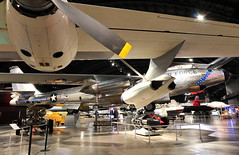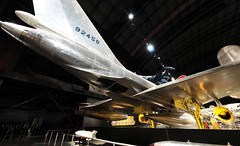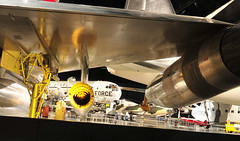 Boeing RB-47H Stratojet: The Boeing B-47 Stratojet was a medium-range and medium-size jet bomber capable of flying at high subsonic speeds and primarily designed for penetrating the airspace of the Soviet Union. A major innovation in post-World War II combat jet design, it helped lead to the development of modern jet airliners. The B-47 never saw major combat use. It served the United States Air Force from 1951 through 1969 and remained a mainstay of the U.S. Air Force's Strategic Air Command (SAC) during the 1950s and early 1960s. The Stratojet on display was one of 32 variants used for long-range reconnaissance missions. The bomb bay was replaced by a pressurized compartment, which accommodated "electronic warfare officers (EWOs)", also known as "Crows" or "Ravens".
Boeing RB-47H Stratojet: The Boeing B-47 Stratojet was a medium-range and medium-size jet bomber capable of flying at high subsonic speeds and primarily designed for penetrating the airspace of the Soviet Union. A major innovation in post-World War II combat jet design, it helped lead to the development of modern jet airliners. The B-47 never saw major combat use. It served the United States Air Force from 1951 through 1969 and remained a mainstay of the U.S. Air Force's Strategic Air Command (SAC) during the 1950s and early 1960s. The Stratojet on display was one of 32 variants used for long-range reconnaissance missions. The bomb bay was replaced by a pressurized compartment, which accommodated "electronic warfare officers (EWOs)", also known as "Crows" or "Ravens". Apollo 15 Command Module: Apollo 15 was the ninth manned mission in the Apollo program, the fourth mission to land on the Moon and the eighth successful manned mission. It was the first of what were termed "J missions", long duration stays on the Moon with a greater focus on science than had been possible on previous missions. It was also the first mission where the Lunar rover was used. The mission began on July 26, 1971, and concluded on August 7. NASA called it the most successful manned flight ever achieved. Commander David Scott and Lunar Module Pilot James Irwin spent three days on the Moon and a total of 18½ hours outside the spacecraft on lunar extra-vehicular activity. The mission was the first not to land in a Lunar mare, instead landing near Hadley rille in an area of the Mare Imbrium called Palus Putredinus (Marsh of Decay). The crew explored the area using the first Lunar Rover allowing them to travel much farther from the Lunar Module lander than had previously been possible. They collected a total of 77 kg (170 lbs) of lunar surface material. At the same time, Command Module Pilot Alfred Worden orbited the Moon, using a Scientific Instrument Module (SIM) to study the lunar surface and environment in great detail using a panoramic camera, gamma ray spectrometer, mapping camera, laser altimeter, mass spectrometer, and lunar sub-satellite that was launched at the end of the mission.
Apollo 15 Command Module: Apollo 15 was the ninth manned mission in the Apollo program, the fourth mission to land on the Moon and the eighth successful manned mission. It was the first of what were termed "J missions", long duration stays on the Moon with a greater focus on science than had been possible on previous missions. It was also the first mission where the Lunar rover was used. The mission began on July 26, 1971, and concluded on August 7. NASA called it the most successful manned flight ever achieved. Commander David Scott and Lunar Module Pilot James Irwin spent three days on the Moon and a total of 18½ hours outside the spacecraft on lunar extra-vehicular activity. The mission was the first not to land in a Lunar mare, instead landing near Hadley rille in an area of the Mare Imbrium called Palus Putredinus (Marsh of Decay). The crew explored the area using the first Lunar Rover allowing them to travel much farther from the Lunar Module lander than had previously been possible. They collected a total of 77 kg (170 lbs) of lunar surface material. At the same time, Command Module Pilot Alfred Worden orbited the Moon, using a Scientific Instrument Module (SIM) to study the lunar surface and environment in great detail using a panoramic camera, gamma ray spectrometer, mapping camera, laser altimeter, mass spectrometer, and lunar sub-satellite that was launched at the end of the mission. Convair B-58A Hustler: The Convair B-58 Hustler was the first operational supersonic jet bomber, and the first capable of Mach 2 flight. The aircraft was developed for the United States Air Force for service in the Strategic Air Command (SAC) during the late 1950s. Originally intended to fly at high altitudes and speeds to avoid Soviet fighters, the introduction of highly accurate Soviet surface-to-air missiles forced the B-58 into a low-level penetration role that severely limited its range and strategic value. This led to a brief operational career between 1960 and 1969. Its specialized role was succeeded by other American supersonic bombers, such as the FB-111A and the later B-1B Lancer. The B-58 received a great deal of notoriety due to its sonic boom, which was often heard by the public as it passed overhead in supersonic flight.
Convair B-58A Hustler: The Convair B-58 Hustler was the first operational supersonic jet bomber, and the first capable of Mach 2 flight. The aircraft was developed for the United States Air Force for service in the Strategic Air Command (SAC) during the late 1950s. Originally intended to fly at high altitudes and speeds to avoid Soviet fighters, the introduction of highly accurate Soviet surface-to-air missiles forced the B-58 into a low-level penetration role that severely limited its range and strategic value. This led to a brief operational career between 1960 and 1969. Its specialized role was succeeded by other American supersonic bombers, such as the FB-111A and the later B-1B Lancer. The B-58 received a great deal of notoriety due to its sonic boom, which was often heard by the public as it passed overhead in supersonic flight. Below the wing of the B-58 Hustler one can see various aircraft located at the south west end of the Cold War Gallery:
Below the wing of the B-58 Hustler one can see various aircraft located at the south west end of the Cold War Gallery:North American F-86D Sabre: all-weather interceptor with skin removed to show the internal structure and placement of equipment
Boeing KC-97L Stratofreighter: tanker version of the cargo version of the B-29
Republic F-84F Thunderstreak: swept-wing turbojet fighter-bomber
Radioplane OQ-19D: fast aerial target with which to train anti-aircraft gunners
Grumman HU-16B Albatross: amphibious utility aircraft which could also operate from snow and ice with skis. During the Korean War, Albatrosses rescued almost 1,000 United Nations personnel from coastal waters and rivers, often behind enemy lines. They also made numerous dramatic and hazardous rescues in Southeast Asia, on occasion taxiing many miles over rough, open water when unable to take off.
 Convair B-36J Peacemaker: The B-36 was the largest mass-produced piston engine aircraft ever made. It had the longest wingspan of any combat aircraft ever built (230 ft (70 m)), although there have been larger military transports. The B-36 was the first bomber capable of delivering nuclear weapons, (specifically the first weaponized hydrogen bomb, over 20 feet long and 10 feet in diameter), from within a fully enclosed bomb bay. With a range greater than 6,000 mi (9,700 km) and a maximum payload of 72,000 lb (33,000 kg), the B-36 was the first operational bomber with an intercontinental range. This set the standard for subsequent USAF long range bombers, such as the B-47 Stratojet, B-52 Stratofortress, B-1 Lancer, and B-2 Spirit.
Convair B-36J Peacemaker: The B-36 was the largest mass-produced piston engine aircraft ever made. It had the longest wingspan of any combat aircraft ever built (230 ft (70 m)), although there have been larger military transports. The B-36 was the first bomber capable of delivering nuclear weapons, (specifically the first weaponized hydrogen bomb, over 20 feet long and 10 feet in diameter), from within a fully enclosed bomb bay. With a range greater than 6,000 mi (9,700 km) and a maximum payload of 72,000 lb (33,000 kg), the B-36 was the first operational bomber with an intercontinental range. This set the standard for subsequent USAF long range bombers, such as the B-47 Stratojet, B-52 Stratofortress, B-1 Lancer, and B-2 Spirit.
No comments:
Post a Comment